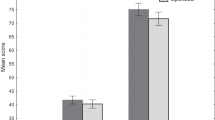Abstract
Aim
Psychological stress is known to affect the immunologic system and the inflammatory response. The aim of this study was to assess the presence of psychological stress, anxiety, and depression in patients with anal fistula.
Methods
Consecutive patients with anal fistula, hemorrhoids, and normal volunteers were studied prospectively. Stressful life events were recorded and subjects were asked to complete the state-trait anxiety inventory (STAI), a depression scale, and three different reactive graphic tests (RGT).
Results
Seventy-eight fistula patients, 73 patients with grade III–IV hemorrhoids, and 37 normal volunteers were enrolled.
Of the fistula patients, 65 (83 %) reported one or more stressful events in the year prior to diagnosis, compared to 16 (22 %) of the hemorrhoid patients (P = 0.001). There were no significant differences in the percentage of subjects with abnormal trait anxiety (i.e., proneness for anxiety) and depression scores between fistula patients, hemorrhoid patients, and controls. Fistula patients had significantly higher (i.e., better) scores compared to hemorrhoid patients in two of three RGT and significantly lower (i.e., worse) scores in all three RGT compared to healthy volunteers.
Of 37 patients followed up for a median of 28 months (range 19–41 months) after surgery, 8 (21.6 %) had persistent or recurrent sepsis. There was no significant difference in depression, STAI, and RGT scores between patients with sepsis and patients whose fistula healed.
Conclusion
Our results suggest that an altered emotional state plays an important role in the pathogenesis of anal fistula and underline the importance of psychological screening in patients with anorectal disorders.




Similar content being viewed by others
References
Parks AG, Gordon PH, Hardcastle JD (1976) A classification of fistula-in-ano. Br J Surg 63:1–12
Read DR, Abcarian H (1979) A prospective survey of 474 patients with anorectal abscess. Dis Colon Rectum 22:566–568
Shafik A (1979) A new concept of the anatomy of the anal sphincter mechanism and the physiology of defecation. VI. The central abscess: a new clinicopathologic entity in the genesis of anorectal suppuration. Dis Colon Rectum 22:336–341
Ramanujam PS, Prasad ML, Abcarian H, Tan AB (1984) Perianal abscesses and fistulas. A study of 1023 patients. Dis Colon Rectum 27:593–597
Sainio P (1984) Fistula-in-ano in a defined population: incidence and epidemiological aspects. Ann Chir Gynaecol 73:219–224
Devaraj B, Khabassi S, Cosman BC (2011) Recent smoking is a risk factor for anal abscess and fistula. Dis Colon Rectum 54:681–685
Grewal H, Guillem JG, Quan SH, Enker WE, Cohen AM (1994) Anorectal disease in neutropenic leukemic patients. Operative vs. nonoperative management. Dis Colon Rectum 37:1095–1099
Cohen JS, Paz IB, O’Donnell MR, Ellenhorn JD (1996) Treatment of perianal infection following bone marrow transplantation. Dis Colon Rectum 39:981–985
Malik AI, Nelson RL (2008) Surgical management of anal fistulae: a systematic review. Colorectal Dis 10:420–430
Kiecolt-Glaser JK, Glaser R (2002) Depression and immune function: central pathways to morbidity and mortality. J Psychosom Res 53:873–876
Gouin JP, Kiecolt-Glaser JK (2011) The impact of psychological stress on wound healing: methods and mechanisms. Immunol Allergy Clin North Am 31:81–93
Lambert GP (2009) Stress-induced gastrointestinal barrier dysfunction and its inflammatory effects. J Anim Sci 87(14 Suppl):E101–E108
Spielberger CD, Gorsuch RL, Lushene R (1970) The state-trait anxiety inventory (S.T.A.I.). Test manual for form X. Consulting psychologist press, Palo Alto
Calia R, Lai C, Aceto P et al (2011) Preoperative psychological factors predicting graft rejection in patients undergoing kidney transplant: a pilot study. Transplant Proc 43:1006–1009
Pritchard MJ (2009) Managing anxiety in the elective surgical patient. Br J Nurs 18:416–419
Goligher JC, Ellis M, Pissidis AG (1967) A critique of anal glandular infection in the aetiology and treatment of idiopathic anorectal abscesses and fistulas. Br J Surg 54:977–983
Magalhaes JG, Tattoli I, Girardin SE (2007) The intestinal epithelial barrier: how to distinguish between the microbial flora and pathogens. Semin Immunol 19:106–115
Mazzon E, Sturniolo GC, Puzzolo D, Frisina N, Fries W (2002) Effect of stress on the paracellular barrier in the rat ileum. Gut 51:507–513
Soderholm JD, Yang P-C, Ceponis P et al (2002) Chronic stress induces mast cell-dependent bacterial adherence and initiates mucosal inflammation in rat intestine. Gastroenterology 123:1099–1108
Marshall GD (2011) The adverse effects of psychological stress on immunoregulatory balance: applications to human inflammatory diseases. Immunol Allergy Clin North Am 31:133–140
Hart AL, Kamm MA (2002) Review article: mechanisms of initiation and perpetuation of gut inflammation by stress. Aliment Pharmacol Ther 16:2017–2028
Tozer PJ, Whelan K, Phillips RK, Hart AL (2009) Etiology of perianal Crohn’s disease: role of genetic, microbiological, and immunological factors. Inflamm Bowel Dis 15:1591–1598
Hamadani A, Haigh PI, Liu IL, Abbas MA (2009) Who is at risk for developing chronic anal fistula or recurrent anal sepsis after initial perianal abscess? Dis Colon Rectum 52:217–221
Wang D, Yang G, Qiu J et al (2014) Risk factors for anal fistula: a case-control study. Tech Coloproctol 18:635–639
Salmon P (2001) Effects of physical exercise on anxiety, depression, and sensitivity to stress: a unifying theory. Clin Psychol Rev 21:33–61
Stewart-Knox B, Duffy ME, Bunting B, Parr H, de Almeida MD V, Gibney M (2012) Associations between obesity (BMI and waist circumference) and socio-demographic factors, physical activity, dietary habits, life events, resilience, mood, perceived stress and hopelessness in healthy older Europeans. BMC Public Health 12:424
Miliacca C, Gagliardi G, Pescatori M (2010) The ‘draw-the-family test’ in the preoperative assessment of patients with anorectal diseases and psychological distress: a prospective controlled study. Colorectal Dis 12:792–798
Holmes TH, Rahe RH (1967) The social readjustment rating scale. J Psychosom Res 11:213–218
Acknowledgments
The authors wish to thank Dr. Liana Spazzafumo for her statistical advice, Dr. Vlasta Pozdemny for reviewing the English language, and Ms. Caterina De Bono who helped with the follow-up of the patients.
Author information
Authors and Affiliations
Corresponding author
Electronic supplementary material
Below is the link to the electronic supplementary material.
ESM 1
(DOC 25 kb)
Rights and permissions
About this article
Cite this article
Cioli, V.M., Gagliardi, G. & Pescatori, M. Psychological stress in patients with anal fistula. Int J Colorectal Dis 30, 1123–1129 (2015). https://doi.org/10.1007/s00384-015-2245-3
Accepted:
Published:
Issue Date:
DOI: https://doi.org/10.1007/s00384-015-2245-3




